Nintendo Switch Lite review: back to the future
Does a Nintendo Switch that doesn't switch make sense? Read T3's official Nintendo Switch Lite review now to find out


The Nintendo Switch Lite delivers a classic portable handheld gaming experience that makes enjoying the Japanese maker's top selection of software on the go a pleasure. Sacrifices in terms of features, as well as near-identical performance to the existing Switch, though, mean that it certainly isn't a must-buy for every gamer.
-
+
Slim and stylish design
-
+
Sharper, if smaller screen
-
+
Good battery life
-
+
Comes with a proper D-pad
-
+
Cheaper than full-fat Switch
-
-
Cannot connect and play on a TV
-
-
Joy-Cons are fixed in place
-
-
No built-in rumble or kickstand
-
-
Only 32GB of internal storage
Why you can trust T3
If you're on the hunt for the best handheld console then this Nintendo Switch Lite review is the only place you'll need to look.
Following on from its popular older sibling, the Nintendo Switch, the Nintendo Switch Light takes almost everything you know and love about the fully-formed console and packs it all into a handheld device.
The word handheld is where this Switch Lite review begins and ends, really, as this new system marks a very assured, comfortable return to Nintendo's roots. As you'd expect, they've done it well, it brings up memories of the long-lost Game Boy Advance.
In many ways, there is an emotional juxtaposition to deal with in that you know, on the whole, this system is not only false to the concept behind the Switch but weaker than it in some aspects, too.
But in saying that, it is also stronger in some ways, but I think the overriding question anyone needs to ask themselves when thinking about purchasing this system is that, simply, do you want a handheld console? If so, then Nintendo has effortlessly pushed out a fantastic portable here, just as it did pre-Switch for decades.
Nintendo has previously shown us the sort of next-level functionality a console can deliver, with the hybrid nature of the original Switch a large part of its huge success, if that's the sort of experience you're looking for then the Lite is almost certainly not for you. Be under no illusion, the Lite is not a successor to the Nintendo Switch and it is worlds apart from the new Nintendo Switch OLED.
That said, let's get stuck into the meat of this Nintendo Switch Lite review, which I've broken down into a variety of key scoring areas. These range from price, availability and what's in the box, through design, build quality and screen, and onto performance and features.
Get all the latest news, reviews, deals and buying guides on gorgeous tech, home and active products from the T3 experts
Nintendo Switch Lite review: official launch trailer
Nintendo Switch Lite review: price, availability, and what's in the box
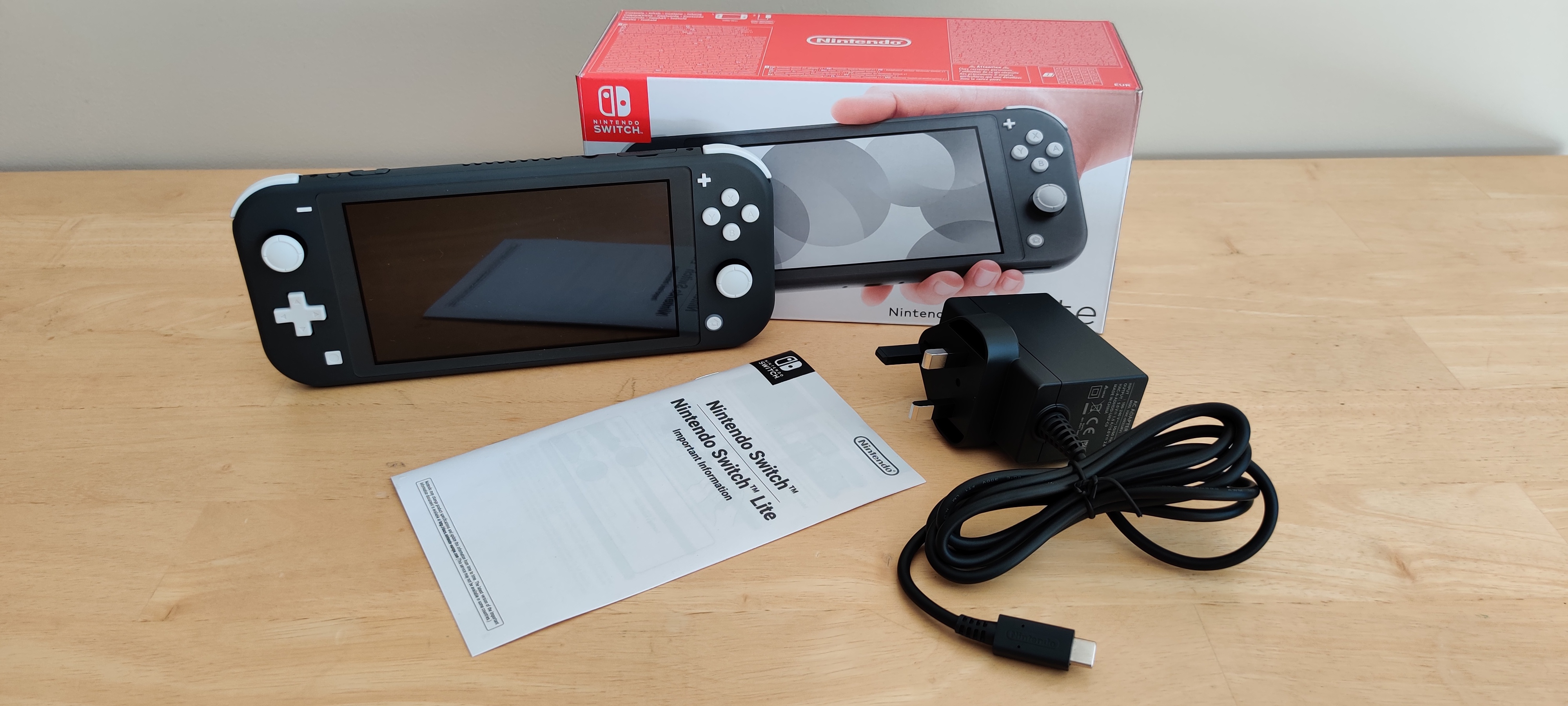
The Nintendo Switch is available now from a wide-variety of retailers, including Amazon, Walmart, BestBuy, Currys, John Lewis, AO, ShopTo, Very, Argos, Smyths Toys and the official Nintendo Store, among others.
Prices range from the RRP of £199.99 down to the mid-to-high £180s, with ShopTo for example offering the Lite right now for £187.85, which is a 6% discount on RRP.
My analysis of pricing on the Nintendo Switch Lite is that a price point of £179.99 would be better (maybe we can expect to see this in the Winter holiday season sales?), and £149.99 would make it very attractive to many gamers. Right now I feel £199.99 is a little too high to make it a super attractive proposition for gamers, and especially so if they already own the original Nintendo Switch. After all, you can currently pick up a full-fat Switch for around £230.
In terms of colourways, there are three standard to choose from, Grey, Yellow, and Turquoise. There is currently also a Pokémon-themed console available for pre-order, which is pink.
In the Nintendo Switch Lite box you get the handheld console, a power plug for it, as well as a safety information booklet.
Nintendo Switch Lite review: design, build quality, and screen
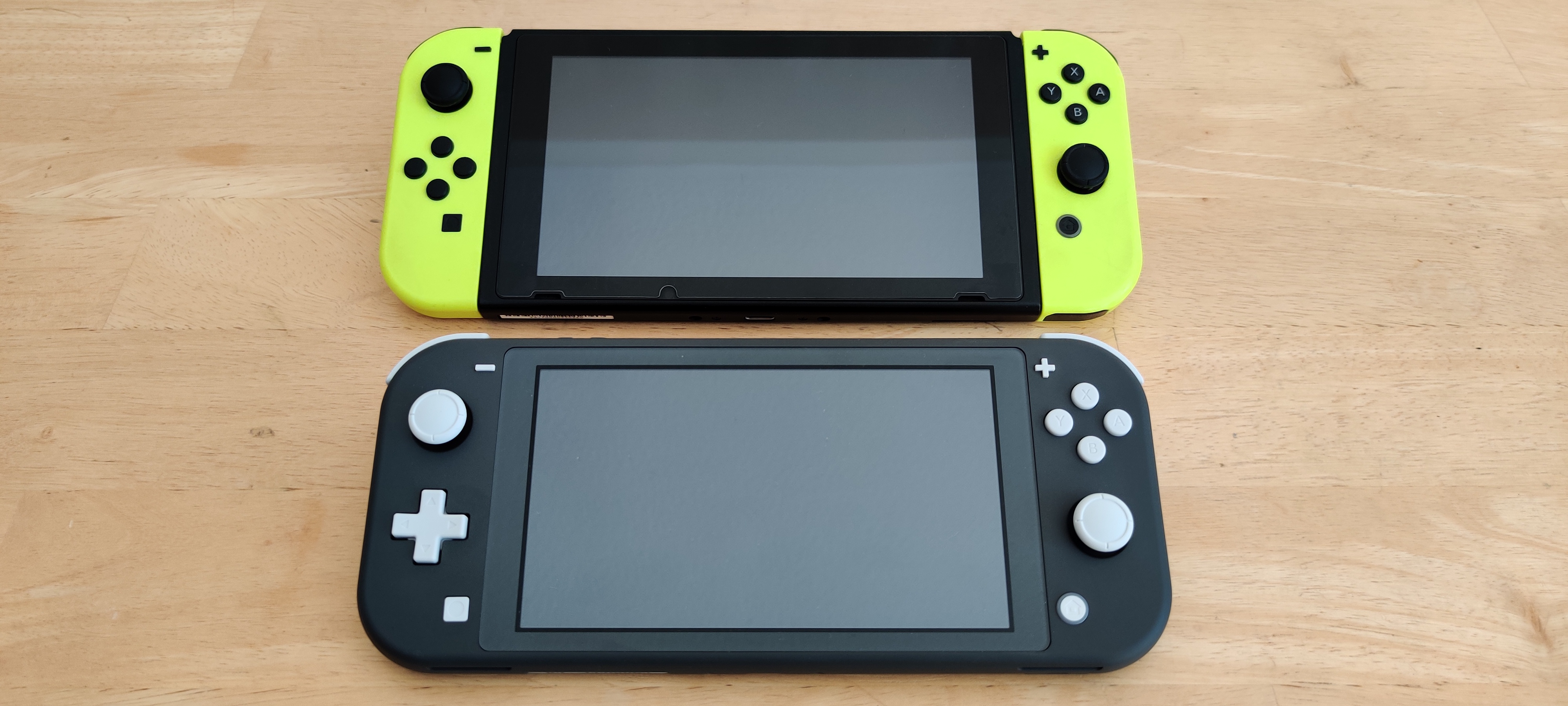
Open the pleasingly compact and stylish Nintendo Switch Lite box and you are presented with a system that, right from the off, pleases to both the hand and the eye. The Switch Lite is noticeably smaller (91.1mm x 208mm x 13.9mm compared to the Switch's 102mm x 239mm x 13.9mm) than the original and, thanks to smoother, rounder case edges and a new matte finish, is noticeably more comfortable to hold.
The Lite is noticeably lighter as well (275g compared to the Switch's 297g), as you would hope from a system with that name, and while the unit I tested is the less visually exciting adult grey colourway, the simple two-tone design, with creamy white buttons and thumbsticks standing out markedly from the grey casing, manages to avoid any toy aesthetic.
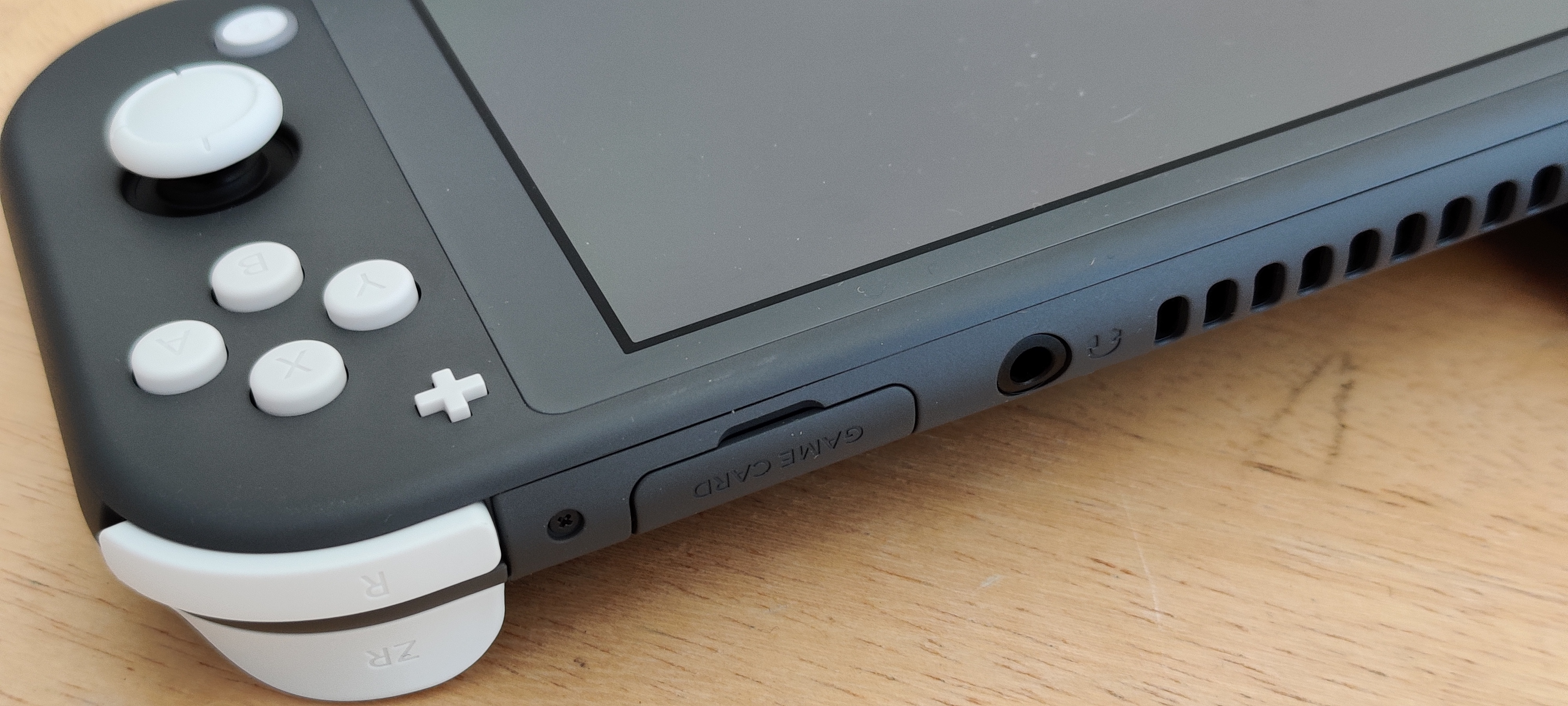
Indeed, while the system is lighter than the Switch, which had a very pleasing weight that communicated an aura of premium hardware, the Lite does not feel flimsy or cheap and plasticy. It is only really when you tap your knuckles on the casing do you get a sense that this system is a cheaper, less dense console.
Changes to design are few but very important to note. The Switch Lite's micro SD card slot is located on the bottom of the case under the right thumbstick. This is accessed via a traditional pull away tab as, unlike the full-fat Switch, the Lite does not have a kickstand built in. It also does not have an ambient light sensor built in, either, so brightness cannot be automatically altered.
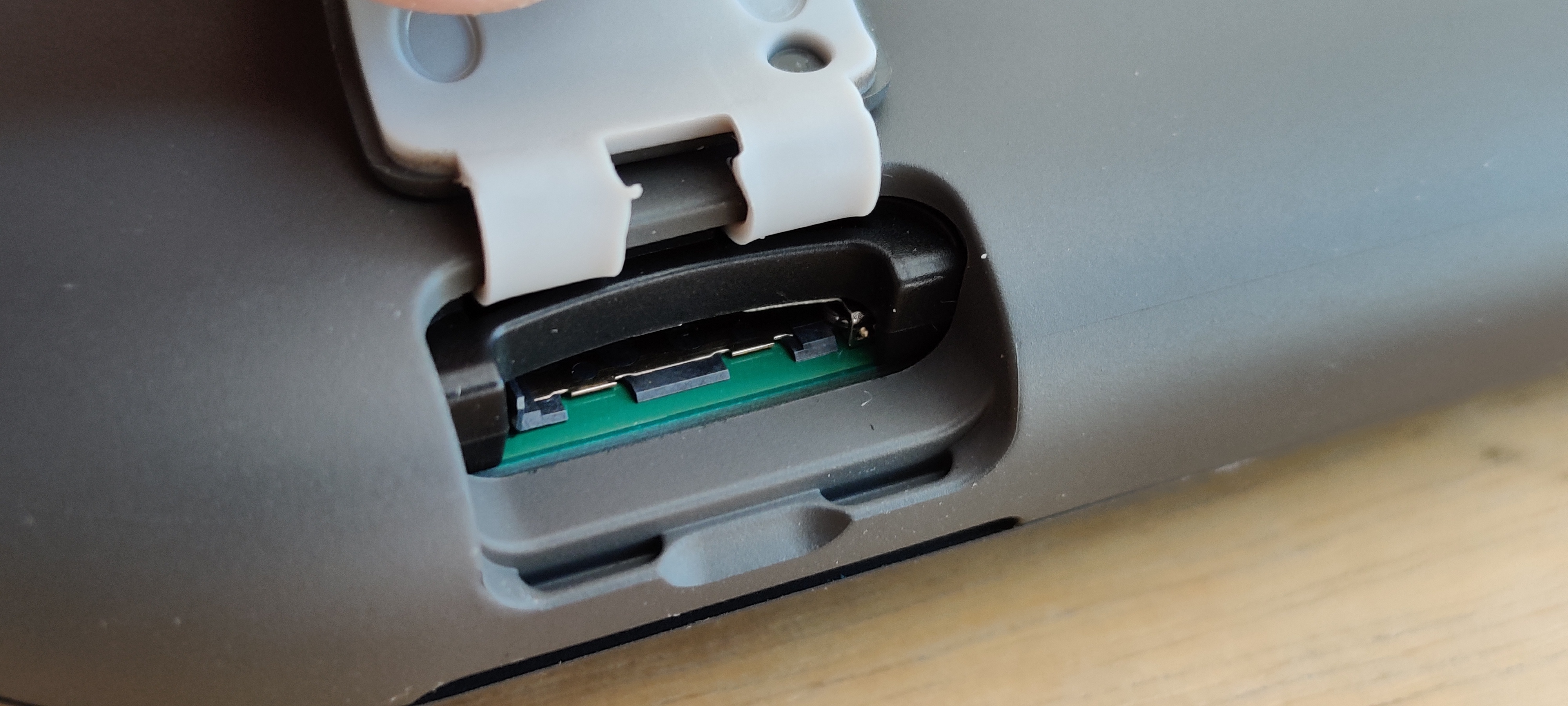
Cooling vent, power and volume buttons, game card slot, power port and audio jack are identically positioned as on the Nintendo Switch. The Switch Lite's thumb stick and button lay out is also the same, however due to the more compact casing, the right thumbstick is now in the bottom right hand corner of the device, rather than centrally positioned on the right Joy-Con.
The result of this is that your right thumb needs to bend a little more to sit on the stick, which is slightly less comfortable over elongated play sessions. Naturally, if you have small hands this won't be so much of an issue. There is also no built-in rumble to this fixed Joy-Con console.

The most noticeable change though in terms of controls is that the Switch Lite boasts a proper D-pad, unlike the Switch's four small separate direction buttons. I found the D-pad comfier and better to use in games, specifically in classic titles that were designed for a D-pad control input. I actually think the D-pad looks better, too.
Screen-wise the Nintendo Switch Lite comes with a 5.5-inch screen, which as with the system's casing, is slightly smaller than the Switch's 6.2-inch display. Both screens share the same 720p (1280 x 720) resolution, though, and the result of that is that images actually look sharper and punchier on the Switch Lite. I would also note here that the Lite's screen does not feel too small, and it is only when you put the handheld side-by-side with the Switch that the difference becomes apparent.
Nintendo Switch Lite review: setup, performance and features
If you don't already have a Nintendo Switch then setup on the Switch Lite is very straight forward. You create your Nintendo ID, log in, tie the console to your account, and then start playing games. If, though, like me, you already have a Nintendo account and Nintendo Switch console and intend to use the Lite as a secondary, portable-focussed system, things get a little bit more complicated.
When you first boot up the system, for example, the setup wizard asks you if you intend to use the system as a secondary device, and once you say yes it naturally asks you to log in with your Nintendo ID. The problem I found, though, was the machine kept then saying I couldn't log in as a system update was required, but the problem with that is that you can't update the system in the initial setup.
This meant that I had to create a temporary new user so I could reach the home screen and settings option, to then update the system, to then go into the profiles menu and then add my original Nintendo Switch account. Now don't get me wrong, this was a minor annoyance, but it still felt like something that could've been a lot slicker.

And, speaking of running a Lite and an original Switch side-by-side, every time I went to boot a game up on the Switch Lite, the system threw up a small pop-up that informed me that it was "checking whether this software can be played". This is because the console was checking to see if the game was being played on my full-fat Switch at the same time, via the internet. If it detects that the software is already running on the other system then you get an error code and refuses to run.
To be clear, this checking only takes place on an account's secondary system. It is definitely something to keep in mind, though, if you plan to run with two Switch systems. As if you and another family member, for example, both want to play a hot new game, and you each take ownership of a console, then you will not be able to play at the same time.
In terms of battery life, the Nintendo Switch Lite beats the Nintendo Switch comfortably, with a run-time of 3-7 hours easily outlasting the 2.5-5.5 hours of the original. However, the Switch Lite does not beat the battery life of the new Nintendo Switch that launched earlier this year, which is identical to the original but delivers a battery life of 4.5 to 9 hours.
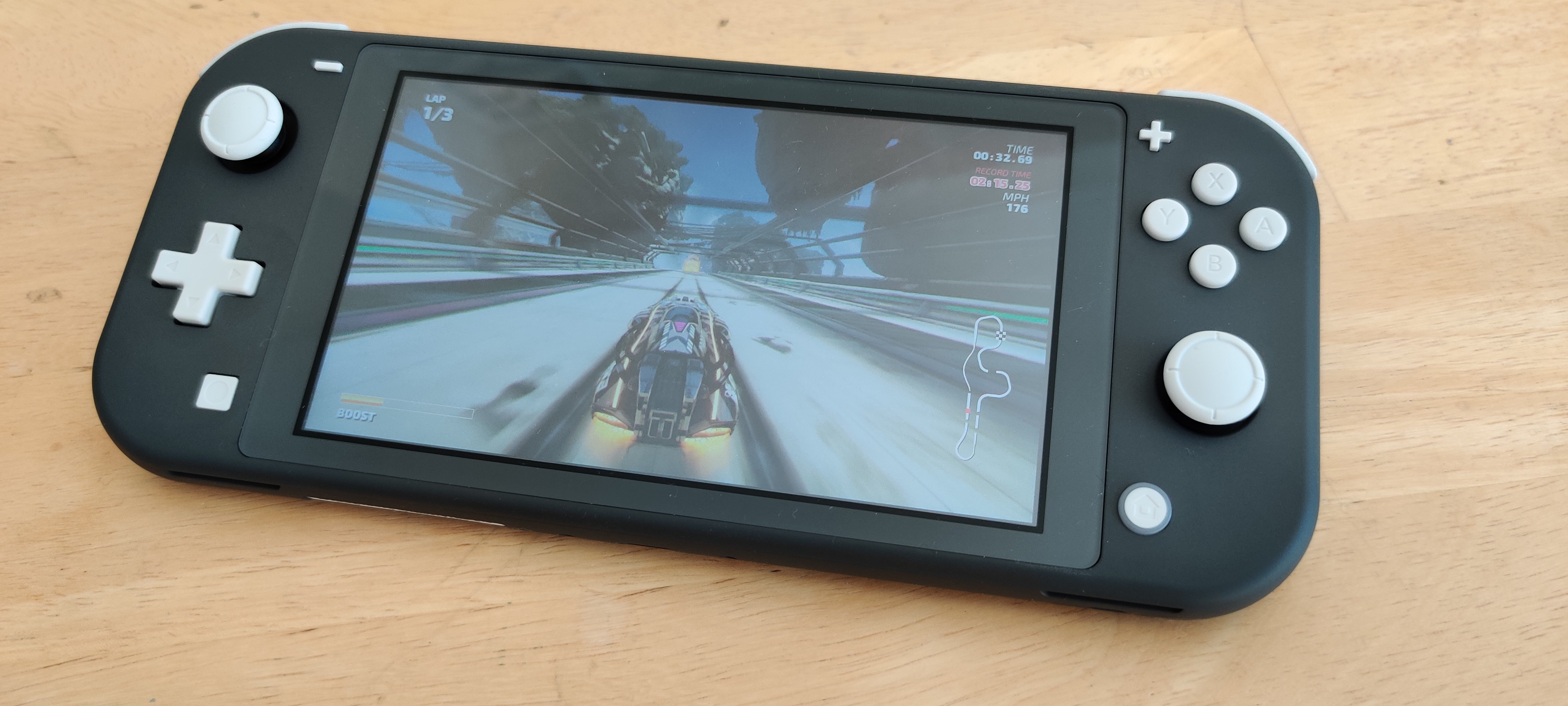
If you are already a Switch gamer, then which system you have will largely determine whether you feel the Switch Lite's battery is an upgrade or a downgrade. I've used every Nintendo Switch system and, after using the Lite, I feel that the battery life is good and, for me at least, easily lasted through any day's usage.
As I noted in our original Nintendo Switch review, I felt that system's battery was underwhelming but still didn't really find it an issue during daily use, as the two or three times a day where I could sneak in some playtime, that never even approached the system's battery life limit. I think it fair to say that most people using the Switch won't play it more than 3-4 hours a day between charges, so in that sense the Lite's 3-7 hours feels fine.
Look, I am not saying it is ideal, as the age of handheld consoles lasting days, weeks or even months between charges or battery changes (my Neo-Geo Pocket Color is legendary in this regard, capable of going on and on and on) are long gone, but it certainly isn't anything to write home about.
As I mentioned above, the visual experience of playing games on the Switch Lite is, actually, maybe a little bit better than on the Nintendo Switch. Yes, the screen isn't as big, but it is sharper and in games like Doom (2016 reboot), where the in-game resolution is low on Switch compared to the far more powerful PS4 and Xbox One, this sharpening of the visuals makes it a better experience to the eye.

As with the revised Switch this year, performance in games is identical to the original Nintendo Switch. Games ran, to my eye, identically on both systems, so anyone who thinks they're going to get a performance boost can think again. Playing games like Fast Racing Neo, Octopath Traveller, Ultra Street Fighter II, Bayonetta 2 and Marvel Ultimate Alliance was still a very enjoyable experience, though, and felt every bit as good as on the full-fat Switch.
As alluded to above, too, the new D-pad makes playing classic titles feel more traditional and, as many of those retro titles were designed to use it, easier to control.
In terms of audio performance, the Switch Lite's stereo speakers remain capable of being cranked up to really quite loud levels, however their quality remains low and, as with the Switch before it, I would recommend the system only ever get played with a decent pair of wired headphones plugged in. For children, though, who want to make sure their parents hear every "WAHAH!" and "WOOHOO!" orated by the portly Italian plumber then the Switch Lite will deliver.
Lastly, I feel I need to note that once more I was left a little frustrated with the just-scrapes-over-the-line 32GB of internal storage available out of the box with the Lite. Simply put, if you intend to have more than a brace of modern video games on the Switch Lite, then you are definitely going to need to add in additional micro SD card storage.
Nintendo Switch Lite review: verdict

Overall, then, Nintendo seems to have in many ways taken a step back in time with the Switch Lite. It is a traditional handheld console experience, and one that sheds the key sell of the original console it shares part of a name with in order to achieve that.
Why has Nintendo released a Switch that can't, well, switch? In my mind it to solidify and reinforce its big cash cow brand at the minute (the Switch is a household name now), while also making a big play to fend off the rapid growth in mobile phone gaming.
A smaller, lighter, cheaper, handheld-only Switch Lite goes a long way to do this, even if it will no doubt leave hardcore gamers and existing Switch owners scratching their heads somewhat with the Lite's better but not better package.
I think I can definitely recommend the Nintendo Switch Lite wholeheartedly, while also acknowledging that it definitely isn't a product for everyone. Will the Switch Lite sell well come this Winter holiday period? Almost certainly. But I imagine many of those sales will be for children and teens who don't already have a Switch console.
At the end of the day, though, as is always the case with Nintendo, I can seen many older gamers eventually picking a Lite up due to the Big N's amazing library of awesome games (Fall and Winter 2019 looks particularly spectacular) and that seemingly unique ability to remind them of the joy-filled days of their youth.
So, the Nintendo Switch Lite is, in many respects, an incredibly smart and fear-free move by the Japanese company. I feel by stripping away core elements of the Switch while keeping the same branding, it has produced a console that will sell well in younger demographics, and reinforced the Switch name as a brand in the market, too. And the continued success of the Switch is something that, personally, I think all gamers can get behind, even if the Lite may very well not be a product designed for them.

Rob has been writing about computing, gaming, mobile, home entertainment technology, toys (specifically Lego and board games), smart home and more for over 15 years. As the editor of PC Gamer, and former Deputy Editor for T3.com, you can find Rob's work in magazines, bookazines and online, as well as on podcasts and videos, too. Outside of his work Rob is passionate about motorbikes, skiing/snowboarding and team sports, with football and cricket his two favourites.